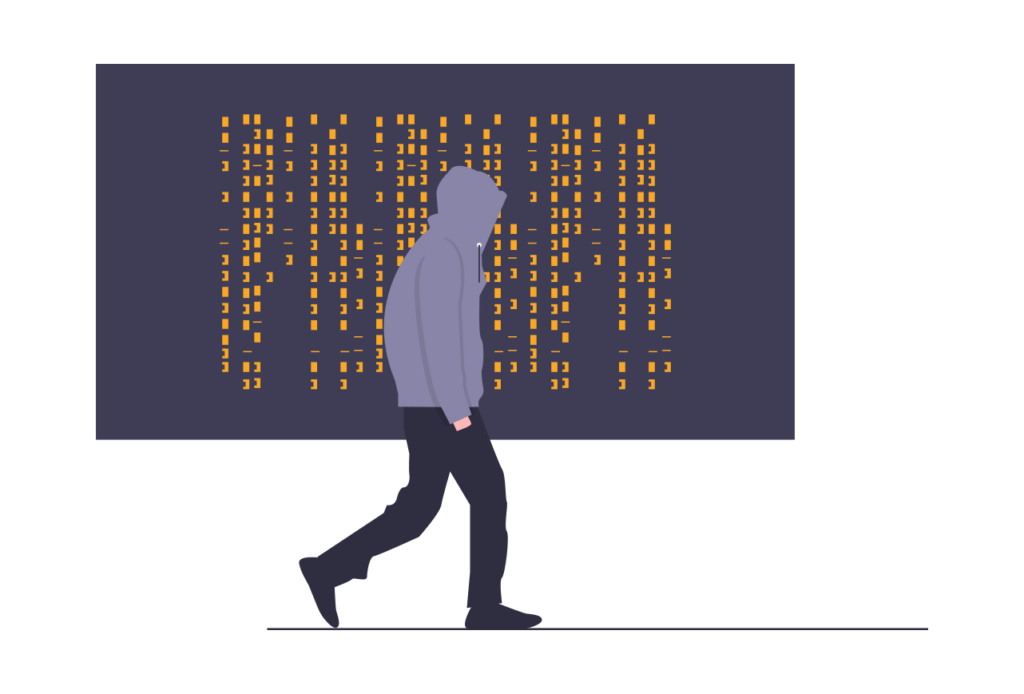IT Security Risks
In this article, we take a closer look at the definition of IT security risks to establish a basic understanding of the complex dangers that businesses and organizations face.

IT Security Risks: A Definition
IT security risks refer to potential threats, vulnerabilities, or uncertainties in information technology that can jeopardize the confidentiality, integrity, or availability of data and IT resources. These risks can vary in nature and range from technological vulnerabilities to human errors and targeted cyber attacks. A comprehensive definition is crucial to capture the various aspects that can affect IT security.
Aspects of IT Security Risks
Technological vulnerabilities: This includes software errors, security flaws, and outdated systems that may enable attackers to gain unauthorized access.
Human error: Carelessness, lack of security awareness, or intentional actions by employees can pose security risks.
Cyber attacks: These encompass attacks such as malware, phishing, denial-of-service (DoS), and ransomware, aiming to steal data, disrupt systems, or cause financial harm.
Regulatory requirements: Changes in legal regulations and data protection provisions can also be considered as risks if organizations do not respond appropriately.
What Happens When Companies Fail to Take IT Risks Seriously?
Companies that ignore or underestimate the importance of IT risks expose themselves to a broad spectrum of potentially severe consequences. In this section, we take a look at the possible impacts when companies neglect these challenges.
Data loss and privacy violations: Paying insufficient attention to IT risks can lead to significant privacy violations and data losses. Cyberattacks, insecure systems, or human errors may expose sensitive information to the wrong hands, affecting not only the company’s reputation but also resulting in legal consequences.
Financial losses: The financial impacts of IT incidents can be substantial. Companies may need to bear not only the direct costs of addressing security vulnerabilities and data recovery but might also face revenue losses. Long-term financial burdens can jeopardize the competitiveness and stability of the company.
Operational disruptions: A lack of focus on IT risks increases the likelihood of operational disruptions due to cyber threats, technological failures, software errors, and even natural disasters. IT system failures can result in production losses, disruptions in the supply chain, and business disturbances, affecting the company’s productivity and profitability.
Data security and compliance risks: Neglecting IT risks can lead to uncertainties regarding data security and data protection. Companies that do not adequately respond to compliance requirements expose themselves to legal risks ranging from fines to business closures.
Reputation loss and customer trust: IT security incidents can significantly shake customer trust. A company neglecting the protection of sensitive information risks substantial reputation loss, negatively impacting customer retention and brand image.
Legal consequences: Ignoring IT security risks can lead to legal problems, especially in the case of data breaches. Companies may have to pay fines and deal with legal actions from customers or regulatory authorities.
Innovation hindrance: Companies ignoring IT risks may hinder their own innovation process. The lack of investment in new technologies and security solutions can cause companies to fall behind industry trends and lag in competitiveness.
Employee retention and satisfaction: Uncertainty about the security of company data can affect employee retention and satisfaction. Employee awareness of IT security risks is crucial, and companies neglecting these concerns risk losing qualified staff.
Underestimating IT risks extends far beyond the realm of cybersecurity. Companies must pursue a comprehensive strategy that covers not only the technological aspects but also the legal, financial, operational, and cultural dimensions of IT security. Only through a holistic approach can companies minimize the potential consequences of IT security risks and operate successfully in the long term.

Examples of the Most Common IT Risks in Companies
The most common IT risks in companies can be diverse, affecting various aspects of information technology. Here are examples of some of the most prevalent IT risks:
Lack of IT governance: Weaknesses in IT governance, such as unclear responsibilities and inadequate processes, can impact risk control.
Outdated IT infrastructure: Outdated software and hardware can have security vulnerabilities and are susceptible to disruptions and attacks. A lack of security updates and patches increases this risk substantially.
Lack of employee security awareness: Inattentive employee behavior, such as opening phishing emails, using insecure passwords, or errors in configuring critical systems, can increase IT risks.
Staff shortages and skill gaps: A shortage of qualified personnel and skilled IT professionals can hinder the company’s ability to handle IT situations.
Malware and ransomware: Malicious software, including viruses, trojans, and ransomware, poses a serious threat and can lead to significant data losses and operational disruptions.
Lack of disaster recovery and business continuity planning: The absence of plans for recovery after data loss or system failure can result in prolonged operational disruptions and financial losses.
Insecure cloud usage: Inadequate security measures when using cloud services can lead to data leaks and unauthorized access.
Missing or insufficient backups: A lack of regular backups can lead to data losses, especially in ransomware attacks.
Supply chain risks: Insecure supply chains can lead to security vulnerabilities, especially if third-party providers are not adequately vetted.
Mobile devices and BYOD risks: Insecure mobile devices and the use of Bring Your Own Device (BYOD) can lead to security issues, especially if not properly controlled by mobile device management (MDM) systems.
Regulatory non-compliance: Failure to comply with data protection regulations and other legal requirements can lead to legal consequences and fines.
Physical security risks: Inadequate physical security measures, such as access to server rooms, can lead to unauthorized access and theft of hardware.
Technological advancement and new attack methods: The rapid development of new technologies and attack methods requires constant adaptation of security measures to ward off current threats.
The precise nature of IT risks can vary depending on the industry, company size, and individual circumstances. A comprehensive risk assessment and a proactive security strategy are crucial for effectively managing the various aspects of IT security.
How to Conduct a Detailed IT Risk Analysis
Conducting a detailed IT risk analysis requires a structured approach to capture the various dimensions of IT security. Here is a general guide for a comprehensive IT risk analysis:
Define the scope: Define the scope of the risk analysis, including the systems, processes, and data involved. Identify the relevant laws, regulations, and standards applicable to your company.
Asset identification: Record all relevant IT assets, including hardware, software, databases, networks, and critical business processes.
Threat and vulnerability identification: Analyze potential threats, both internal and external, that may affect your IT assets. Identify vulnerabilities in IT infrastructure, software, networks, and among employees.
Assessment of likelihood and impact: Estimate the likelihood of a threat occurring. Also, assess the potential impacts of an occurrence on the confidentiality, integrity, and availability of information.
Risk quantification: Assign a numerical value to each identified risk representing the combination of likelihood and impact. Prioritize risks based on these values.
Identification of controls: Determine existing security controls and assess their effectiveness. Identify missing controls that could minimize risks.
Develop risk treatment strategies: Develop strategies for treating risks, including acceptance, avoidance, transfer, or reduction. Determine specific actions to implement your risk treatment strategies.
Create a risk report: Document all aspects of the risk analysis, including the identified risks, assessments, controls, and recommended actions. Prepare a report for the relevant stakeholders.
Implementation of measures: Implement the identified security measures to minimize risks. Continuously monitor the effectiveness of the implemented measures.
Ongoing monitoring and updating: Regularly monitor the IT landscape for new threats and vulnerabilities. Update your risk analysis regularly to reflect changing business conditions and threats.
A successful IT risk analysis requires collaboration among various departments, including IT, compliance, legal, and management. It is crucial to repeat the analysis regularly to adapt to changing threats and business requirements.

What are the best practices for managing IT risks?
We would like to share some best practices for managing IT risks. Our recommendations include measures that companies can take to protect their IT infrastructures from various threats.
Establish a security culture: Foster a high level of awareness of IT security at all levels of the company to ensure that employees understand and adhere to the importance of IT security policies.
Regular training and sensitisiation: Conduct regular training sessions for employees on current IT risks, best practices, and guidelines.
Review of third parties: Implement controls for third-party vendors to ensure they adhere to adequate security standards.
Continuous monitoring and analysis: Utilize tools for the continuous monitoring of networks, systems, and applications.
Emergency preparedness and response planning: Develop emergency plans to respond quickly to IT risks and conduct regular drills.
Regular IT security audits: Conduct internal and external audits to identify vulnerabilities and verify compliance with security standards.
Document security policies and processes: Create clear security policies that can be understood and followed by all employees.
Network segmentation: Segment networks to limit damage in the event of a risk incident.
Regular risk assessments: Conduct regular formal risk assessments to review the effectiveness of your risk mitigation strategies.
Automated patch and update management: Implement automated systems for managing patches and updates.
Build partnerships within the IT community: Engage in the IT community to exchange information on current risks and best practices. Don’t hesitate to seek external assistance.
Regular data protection impact assessments: Conduct regular data protection impact assessments to evaluate the effects of data processing activities.
Technological innovation and advancement: Stay up-to-date with technological developments alongside your team to respond appropriately to new risks and challenges.
These best practices can contribute to a comprehensive approach to IT risk management, helping organizations build resilience against evolving threats.
Common IT risks in Swiss companies in 2023
Various IT risks could be particularly significant for Swiss companies in 2023. It’s important to note that the risks listed below are of a general nature, and a specific risk assessment, considering each company’s individual circumstances, is required.
Banking and Financial Sector Risks: As a significant financial hub, Switzerland may face specific risks related to cyber attacks on financial institutions and the processing of sensitive financial transactions.
Data privacy and swiss data protection legislation: Compliance with Swiss data protection laws could become a specific risk, as companies need to ensure they meet the country’s stringent requirements.
Dependency on international business relations: Given Switzerland’s strong international orientation, risks related to international business relations, trade, and data exchange may be prominent.
Regulatory risks in the financial and technology sectors: The specific regulatory requirements for the financial and technology sectors in Switzerland could pose particular challenges for companies.
Integration of innovation and data technologies: Integrating new technologies such as blockchain or artificial intelligence may bring specific challenges due to Switzerland’s innovation culture and presence in the technology sector.
Management of health crises: Given the global challenges posed by health crises, specific risks and challenges for the Swiss economy may be identified, especially regarding the health sector and dependence on international supply chains.

FAQs:
How can I protect my business from IT risks on a budget?
Even with a limited budget, you can protect your company from IT risks. Consider cost-effective measures such as employee training for awareness, regular updates for software and operating systems, and the implementation of free or low-cost security solutions. Additionally, establishing clear policies and regularly reviewing them is essential to ensure a robust IT risk strategy.
How can IT security standards be used to effectively manage IT risks in Switzerland?
In Switzerland, companies can utilize IT security standards such as ISO 27001 to establish a structured and internationally recognized foundation for managing IT risks. By integrating such standards into their practices, Swiss companies can not only enhance their resilience to risks like cyber threats but also ensure compliance with the country’s specific data protection requirements and regulatory standards.
How can businesses stay up-to-date on the latest IT security threats and best practices?
To stay informed about the latest IT security threats and best practices, companies should regularly follow security news, industry blogs, and mailing lists. Participating in training sessions, and conferences, and engaging with security experts allows companies to continuously deepen their knowledge and adjust their security strategies accordingly.
- Microservices - 18.01.2024
- The True Value of Microservices - 15.01.2024
- IT Security Risks - 25.12.2023
